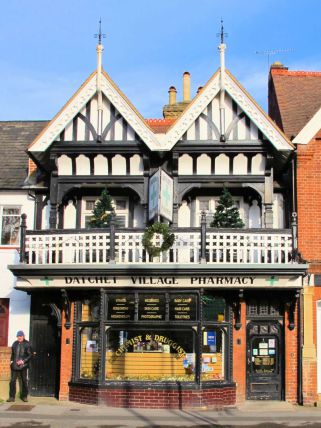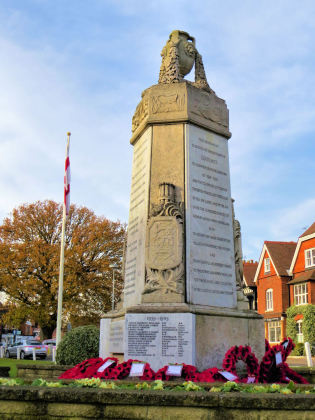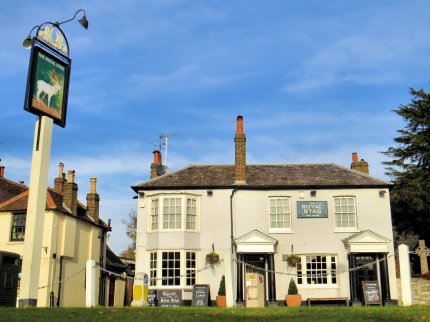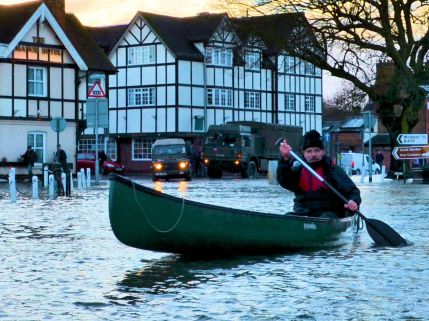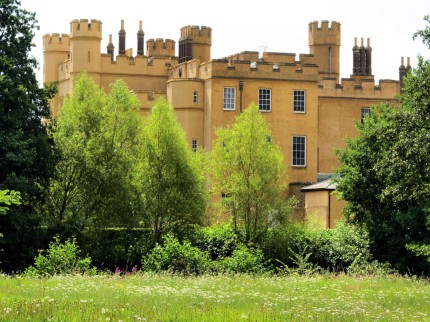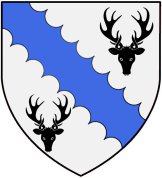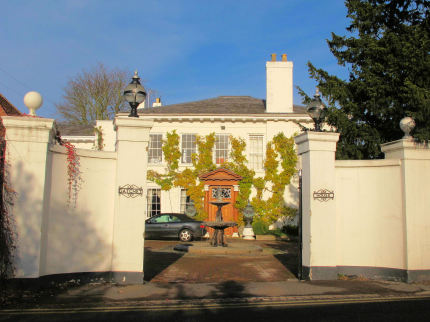
Datchet
Although Eton and Datchet are not part of Slough now, before 1972 the three towns were connected as a local authority within Buckinghamshire and known as Slough and Eton. For this historic reason Eton and Datchet are included in this website.
The earliest written reference to Datchet is from about the year 994AD. The name ‘Datchet’ is of Celtic origin and therefore pre-Roman. The village appears as Daceta in the 1086 Domesday survey.
Datchet village developed because of its position on the Thames. A ferry crossing in medieval times from Windsor Castle to the end of the present High Street provided a route through the village on to Colnbrook to pick up the main road to London. The ferry existed until 1706 when it was replaced by a bridge. The land on the Windsor side of the river was accessible to the public at that time. Tudor and Stuart times saw Datchet become home to royal courtiers and rich London merchants and the village was becoming a commuter village such as it is now.
The discreet presentation of Datchet Village Pharmacy blends in nicely with the Tudor-style building
In 1848 the railway provided a link between Windsor and Staines and beyond. Prince Albert negotiated with the railway company to allow the line through Crown land to the north of Datchet on condition that the original bridge was removed and the castle side of the river became private and inaccessible to the public. The Albert and Victoria bridges were built above and below the village to take new roads to and from Windsor and Old Windsor.
The 12:48 from Datchet to Windsor and Eton Riverside is about to leave platform 2
As a result the railway brought crowds at weekends and Datchet became fashionable and a centre for river pleasure trips, regattas and parties. There was a demand for high-class new houses, particularly those with a river view. Jerome K Jerome visited Datchet in his book Three Men in a Boat. It was the Saturday night before August Bank holiday and he and his companions were tired and looking for somewhere to stay. JKJ was not impressed by the accommodation on offer. This quote from the book is abridged:
‘We passed a very pretty little hotel, with clematis and creeper over the porch; but there was no honeysuckle about it and, for some reason or other, I had got my mind settled on honeysuckle. So we went on ’til we came to another hotel. That was a very nice hotel too and it did have honeysuckle on it, round at the side. But Harris did not like the look of the man leaning against the front door. He said he didn’t look a nice man at all and he wore ugly boots. So we went on further…’
Talk about picky! Personally, I would have been less picky and looked past the man with the ugly boots and taken a room there because I quite like honeysuckle too. Allowing the state of a man’s boots cloud your judgment over a pub festooned with honeysuckle seems a little unreasonable.
Post-Second World War, two major projects altered the landscape dramatically; the building of the Queen Mother Reservoir and the building of the M4 motorway. Also Datchet’s position with regard to road and rail travel connections led to inevitable housing developments. In some ways it is a shame that Datchet is at this crossroads because the roads are always noisy and busy in the village parked vehicles spoil the picturesque atmosphere of the village centre. On the other hand, if you took away the through traffic the village might die.
The Obelisk War Memorial
Designed by Sir Lionel Cust, the Obelisk War Memorial on the Green was built in 1920 at a cost of £600. It was unveiled on 8 May the same year. Sir Lionel Cust was an art historian, Editor of the Burlington Magazine, Director of the National Portrait Gallery and Keeper of the King’s Pictures. In the early 20th. In 2011 a thorough restoration was carried out.
Other war memorials in Datchet include the London Road Crucifix constructed in 1919, and the Women’s Memorial, a Celtic cross in St Mary’s churchyard and constructed in 1920.
The Royal Stag
It is believed that The Royal Stag was established in the centre of Datchet since the fifteenth century. Further details from the Royal Stag’s own website indicate that may have initially been called the Five Bells because of the proximity of St Mary’s Church. This link may not be true because of matching the date of the pub with the dates of the development of the church. Later it became the High Flyer until 1796 when it became the Royal Stag. It is now the only pub in the village.
The Royal Stag
Some people believe that the pub might be haunted due to a ‘ghostly hand print’ that is said to appear on a window pane. Here’s the story, enjoy.
According to folklore, sometime during Victorian times, a labourer and his son stopped at the inn on a bleak winter's day. Whilst the father went inside the pub for a drink, his son played outside. The child became cold so he went to the window to get his father’s attention. The man was having such a good time with his beer and company that he didn’t notice. The desperate child pressed his hand against the window but it was too late and the boy collapsed in the snow and perished, leaving a solitary handprint on the glass. From time to time, a small handprint is said to appear on a window.
Oh yawn! Pubs and hotels love ghost stories as they can help to boost business. Of all the stories of ghosts and other legends that I have come across around the UK this is the weakest. Like the ‘evidence’ is hard to fake. Send out for forensics.
The Thames at Datchet
This strip of land on the waterfront is open for public use and has plenty of benches and picnic benches. It is on the B470 Windsor Road opposite Datchet High Street. It is popular with mallard and black-headed gulls who clearly appreciate the view of the Royal Estate in Windsor across the river.
Going south at this point the road becomes the B3021 Southlea Road and there is the boatyard of Kris Cruisers which hires out pleasure cruisers and day boats.
2013-2014 floods
During the 2013/2014 floods, residents of Datchet and Old Windsor suffered terrible misery. The residents blamed the Environment Agency and the construction of the Jubilee River flood relief scheme. The Jubilee parts from the Thames near Taplow and re-joins the Thames just above the two villages and their argument was that this caused twice as much water flow as before. It didn’t and the simple is that whatever volume of water flowed into the Thames and Jubilee at Taplow is what flowed out just above Datchet with just the additional local rainfall which would have been there with or without the Jubilee.
An enterprising canoeist in the middle of the village. In the background is a British Army Land Rover and a Leyland DAF utility truck. To the left is the Manor Hotel. Photo taken 12 February 2014.
In defence of the Environment Agency and the Jubilee and Thames system, it was used by the Environment Agency to store as much water as possible to try to protect towns such as Datchet. It also flooded fields as an attempt to store excess water. There had been nearly two months of almost continuous heavy rain culminating in a big storm that hit the upper Thames In February 2014. The rising water levels became unmanageable.
The most severely affected areas in East Berkshire where in Bisham, Cookham, Datchet, Horton, Old Windsor and Wraysbury.
Taking a break, these guys have been so busy either trying to contain the floods or allow flooding in areas where they would do little damage such as on Dorney Common.
Meteorological events that led to the floods
A series of low pressure areas developed or formed over North America deepening over the Atlantic Gulf Stream before reaching European coasts. On 19 December 2013 Cyclone Dirk hit Britain and 60mm of rainfall saturated the ground and caused localised flooding. Some 100,000 homes were reported to be without electricity.
On 30 January 2014 the Met Office reported that Southern England and other parts of the country had experienced their highest January rainfall since records began in 1910. Another storm arrived on 8 February especially the upper Thames. On 10 February flood levels rose dramatically in Datchet and other towns in the south-east, largely due to the high rainfall in the upper Thames.
Princes William and Harry helped out with flood defences at a local private school after its pupils were forced to relocate at a nearby hotel.
Datchet has a history of flooding from the 1600s onwards, a long time before the Jubilee was built. The ‘great floods’ occurred in the years 1774, 1809, 1822, 1852, 1894 and 1947. From the historic records all of them seem to have been more severe than that of 2014, although it is difficult to compare the rural village with the modern built-up area.
In rural countryside heavy rainfall will largely be soaked up by the soil. In towns and cities there are many areas of hard man-made structures such as roads, parking areas, housing, office blocks, factories etc. when rain falls it has to go somewhere so it goes into storm drains and can end up directly into streams rather than filtering through soil.
This is a field in Eton Wick near the Jubilee River at Slough on 2 February 2014.
St Mary’s Church
The first church on the site was probably Anglo-Saxon and of timber construction. From 1066 the Norman Family the de Pinkneys, took control of the parish and the church was first referred to in the mid-1100s by Gilbert de Pinkney.
In 1350, the church was given as an endowment by Edward III to his new Chapel of St George in Windsor. The chapel was responsible for the upkeep of the chancel which seems to have been rebuilt from the mid-14th century. There were no resources left however, to pay for looking after the rest of the building.
From the early Tudor period the church was reported to be in almost ruinous conditions and the cost of repairs fell largely on the parishioners. In 1818, a certain parishioner called James Randall, left money in his will to build a vestry and provide a clock, the mechanism of which still survives in the new tower.
By the mid-19th century, Anglican evangelism led to the restoration of old churches throughout the country. Renovation of St Mary’s began in May 1857. The architect was Raphael Brandon who designed it in the Gothic Revival style which was thought apt for a village church. Raising enough money was difficult and the building programme was done in a piecemeal fashion. Work was completed in the late 1860s.
Ditton Park
The River Thames was once the boundary between Bucks and Berks. In 1974, Slough and Datchet were removed from the authority of Buckinghamshire to become part of Berkshire instead. Datchet was also transferred from Slough to the Royal Borough of Windsor but Ditton Park, which was part of Datchet, remained with Slough. However the major events concerning Ditton Park occurred while part of Datchet and Slough.
Ditton Park belonged to the crown during the reign of Elizabeth I. The house, which may have been built around 1500, was badly damaged by fire and rebuilt in 1812. In 1917 the property was taken over for use by the Admiralty Compass Observatory.
Even today, Ditton Park looks secretive
In 1920 the Radio Research Board was formed by the Department of Scientific and Industrial Research to undertake secret research into radio science. A team of scientists including Admiral of the Fleet Sir Henry Jackson, Sir Edward Appleton, Sir Robert Watson-Watt, Robert Naismith and Reginald Leslie Smith-Rose were eventually located at Ditton Park in 1924.
Ditton Park became known as the Radio Research Station and its achievements included the development of radar by Watson-Watt, and studies on the effects of the ionosphere on radio waves by Appleton, both of which were vital in defeating the Axis powers in the Second World War. Radar was used on ships, aircraft and ground stations. The studies on the ionosphere led to the discovery that high frequency or short wave radio waves could be bounced off this layer of the atmosphere allowing long-range radio communication. The station continued developing research into radio and atmospheric studies and also moved into the field of space research in the late 1950s.
It is remarkable that two of the two main weapons used to defeat the Germans in the Battle of Britain, the development of Radar and the manufacture of the Hawker Hurricane, took place within a mile and a half of each other.
Datchet House
Needham Family
This Georgian house was built for the Needham family by 1747. The Needham family were the Earls of Kilmorey in Ireland but they also owned an estate in Shropshire. Some of them were residents in Iver before buying Datchet House. The main occupant was Anne, the wife of John Needham the 10th Viscount who lived there.
General Francis Needham
John and Anne’s son Francis Needham was Aide-de-Camp to George III in the 1790s He joined the British Army 1762 and served in the American War of Independence, taken prisoner at the Siege of Yorktown in 1781.
He also fought in the French Revolutionary Wars and the Irish Rebellion of 1798. In 1804, he was appointed Colonel of the 5th Royal Veteran Battalion. He was promoted to colonel for life of the 86th Foot in 1810 and to general in 1812.
Francis Needham became Member of Parliament for Newey from 1806-1818. Later he became First Earl of Kilmorey in 1822 but as this was an Irish peerage he wasn’t entitled to take a seat in the House of Lords.
Needham and his wife Anne, continued to own Datchet House through the 1800s. They had two sons and seven daughters a number of these daughters were either spinsters or became widows and lived at the house. Twelve of the family are buried on the east side of St Mary’s churchyard.
Sir Lionel Cust (1859-1929)
Another notable resident in the early 20th century was Sir Lionel Cust, Surveyor of the King’s Pictures and Director of the National Portrait gallery. Lionel Cust bought the house in 1911 moving there from Windsor. He was a personal friend of King Edward VII and became one of the king’s Gentleman Ushers at Court. He took a great deal of interest in the village and designed the main village war memorial in 1920.
He also took a great interest in the lives of ordinary people becoming chairman of the Datchet Co-Partnership Housing & Allotment Society. This organisation which provided some of the first ‘social’ housing in the country in Ditton Road. He brought King George V and Queen Mary to visit the first residents at the cottages in 1919.
Laura la Plante (1904 - 1996)
American silent film star Laura la Plante, who resided there from 1932-1935, had the top storey removed. It doesn’t make sense to make a house smaller and it distorts the proportions of the building making it look rather squat. Nobody understands why and since she was a silent film star she probably couldn’t find the words to tell anybody.
The Manor House
The Manor House is a Grade II Listed building believed to date from the late sixteenth century. It was owned by the Montagues of Beaulieu but let out to various members of the Royal household at Windsor. Occupants included the Royal boatman and the steward of the manor who leased the ferry rights at Datchet from Queen Elizabeth I and subsequent monarchs.
My name is Gary Flint. I'm author, photographer & illustrator for Postcards from Slough. If you wish to make any comments on the contents of the website please click on the ladybird below:
Gary Flint
08/03/1961 - 09/04/2019
Postcards from Slough is an independently funded website. We are open to offers of sponsorship from companies that have any connections to the town. To contact us please click on the ladybird below:
Chalvey Community Forum
Postcards from Slough is linked with a local action group the Chalvey Community Forum. The group liaises with various local organisations in order to improve the quality of life for residents in the ward of Chalvey and Salt Hill. To learn more please click on the maidenhair leaf below:
Museum of Berkshire Aviation
I volunteer as a guide at the Museum of Berkshire Aviation. It is a special museum and if you would like to know more about the museum then please click on the motif below:
To learn more about the museums activities while staying within this website click on the tab at the top of the page or on the motif below:
Graces Guide
Postcards from Slough uses some images from Grace's Guide. Click on the button below:
British Listed Buildings
Postcards from Slough contributes material to British Listed Buildings and uses the site for cross referencing purposes. Click on the button below:
